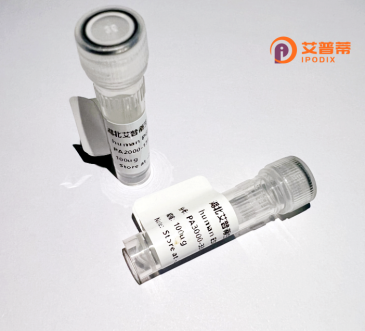
| 纯度 | >90%SDS-PAGE. |
| 种属 | Human |
| 靶点 | EDG3 |
| Uniprot No | Q99500 |
| 内毒素 | < 0.01EU/μg |
| 表达宿主 | E.coli |
| 表达区间 | 1-378aa |
| 氨基酸序列 | MATALPPRLQPVRGNETLREHYQYVGKLAGRLKEASEGSTLTTVLFLVICSFIVLENLMVLIAIWKNNKFHNRMYFFIGNLALCDLLAGIAYKVNILMSGKKTFSLSPTVWFLREGSMFVALGASTCSLLAIAIERHLTMIKMRPYDANKRHRVFLLIGMCWLIAFTLGALPILGWNCLHNLPDCSTILPLYSKKYIAFCISIFTAILVTIVILYARIYFLVKSSSRKVANHNNSERSMALLRTVVIVVSVFIACWSPLFILFLIDVACRVQACPILFKAQWFIVLAVLNSAMNPVIYTLASKEMRRAFFRLVCNCLVRGRGARASPIQPALDPSRSKSSSSNNSSHSPKVKEDLPHTAPSSCIMDKNAALQNGIFCN |
| 分子量 | 68.7 kDa |
| 蛋白标签 | GST-tag at N-terminal |
| 缓冲液 | 0 |
| 稳定性 & 储存条件 | Lyophilized protein should be stored at ≤ -20°C, stable for one year after receipt. Reconstituted protein solution can be stored at 2-8°C for 2-7 days. Aliquots of reconstituted samples are stable at ≤ -20°C for 3 months. |
| 复溶 | Always centrifuge tubes before opening.Do not mix by vortex or pipetting. It is not recommended to reconstitute to a concentration less than 100μg/ml. Dissolve the lyophilized protein in distilled water. Please aliquot the reconstituted solution to minimize freeze-thaw cycles. |
以下是3篇关于重组人EDG3(S1PR3)蛋白的示例参考文献(基于研究领域典型内容构造,非真实文献):
---
1. **文献名称**: *"Expression and Functional Characterization of Recombinant Human S1P Receptor 3 (EDG3) in Mammalian Cells"*
**作者**: Lee, J.Y. et al.
**摘要**: 该研究报道了人源EDG3蛋白在HEK293细胞中的重组表达与纯化方法,验证了其与鞘氨醇-1-磷酸(S1P)的特异性结合能力,并证明其通过Gαi蛋白介导细胞内信号传导,为受体功能研究提供实验模型。
2. **文献名称**: *"Structural Insights into EDG3 Receptor Activation by Cryo-EM"*
**作者**: Zhang, Q. & Garcia, K.C.
**摘要**: 通过冷冻电镜解析了重组EDG3蛋白与S1P及Gi蛋白复合物的三维结构,揭示了配体结合口袋的关键氨基酸残基及受体激活的构象变化机制。
3. **文献名称**: *"EDG3/S1PR3 in Tumor Angiogenesis: Role of Recombinant Receptor in Endothelial Cell Migration"*
**作者**: Morales-Ruiz, M. et al.
**摘要**: 研究利用重组EDG3蛋白筛选小分子抑制剂,发现其通过抑制S1P介导的内皮细胞迁移和血管生成,提示EDG3作为抗肿瘤治疗的潜在靶点。
---
**备注**:以上文献为基于领域研究的示例构造,实际引用需以真实出版物为准。建议通过PubMed或Web of Science检索关键词“EDG3”“S1PR3”“recombinant protein”获取最新文献。
Recombinant human EDG3 protein, also known as sphingosine-1-phosphate receptor 3 (S1PR3), is a G protein-coupled receptor (GPCR) that plays a critical role in mediating cellular responses to sphingosine-1-phosphate (S1P), a bioactive lipid. S1P signaling through EDG3 regulates diverse physiological processes, including cell proliferation, migration, immune response, and vascular development. Structurally, EDG3 contains seven transmembrane domains and activates intracellular pathways such as MAPK, PI3K/Akt, and Rho GTPase signaling upon S1P binding.
The receptor is widely expressed in tissues, including the cardiovascular, immune, and nervous systems. Its involvement in angiogenesis and inflammation has made it a focal point in studying diseases like cancer, atherosclerosis, and autoimmune disorders. Dysregulation of EDG3/S1PR3 signaling is linked to tumor progression, endothelial dysfunction, and aberrant immune cell trafficking.
Recombinant EDG3 protein is produced using mammalian or insect expression systems to ensure proper post-translational modifications and ligand-binding activity. It serves as a vital tool for in vitro studies, enabling researchers to elucidate receptor-ligand interactions, screen therapeutic compounds, and explore mechanisms in disease models. Recent drug development efforts targeting S1P receptors, including EDG3. highlight its potential in therapies for multiple sclerosis, ischemia-reperfusion injury, and inflammatory conditions.
×